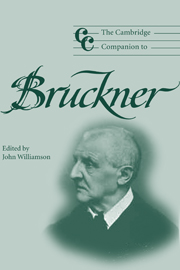Book contents
- Frontmatter
- Part I Background
- Part II Choral music
- Part III The symphonist
- 7 The Brucknerian symphony: an overview
- 8 Bruckner's symphonies – a reinterpretation: the dialectic of darkness and light
- 9 Programme symphony and absolute music
- 10 Bruckner editions: the revolution revisited
- 11 Bruckner and the symphony orchestra
- 12 Between formlessness and formality: aspects of Bruckner's approach to symphonic form
- 13 Formal process as spiritual progress: the symphonic slow movements
- 14 Bruckner and harmony
- Part IV Reception
- Notes
- Select bibliography
- Index
11 - Bruckner and the symphony orchestra
from Part III - The symphonist
Published online by Cambridge University Press: 28 September 2011
- Frontmatter
- Part I Background
- Part II Choral music
- Part III The symphonist
- 7 The Brucknerian symphony: an overview
- 8 Bruckner's symphonies – a reinterpretation: the dialectic of darkness and light
- 9 Programme symphony and absolute music
- 10 Bruckner editions: the revolution revisited
- 11 Bruckner and the symphony orchestra
- 12 Between formlessness and formality: aspects of Bruckner's approach to symphonic form
- 13 Formal process as spiritual progress: the symphonic slow movements
- 14 Bruckner and harmony
- Part IV Reception
- Notes
- Select bibliography
- Index
Summary
Two views on the nature and derivation of Bruckner's orchestral practices have predominated. In the early part of the twentieth century, the prevailing attitude styled Bruckner as a Wagnerian symphonist, and thus characterized his orchestration as a (more or less successful) imitation of Wagner's instrumental textures. With the publication in the 1930s and 1940s of the complete edition under Robert Haas, this view proved hard to sustain, relying as it did on the first published editions, the orchestration of which was often changed, to overtly Wagnerian ends, and without Bruckner's consent. The Wagnerian interpretation consequently ceded to an ‘organistic’ conception: orchestral technique was conditioned above all by the composer's long association with the organ loft.
Opinions on this matter crystallized in the mid-1930s, in a debate between Max Auer, then president of the Bruckner Gesellschaft, and the theorist and analyst Alfred Lorenz. Auer presented perhaps the classic formulation of the organistic view. The basis of his attitude was a belief in the importance of formative musical experience: whatever subsequent influences Bruckner accrued, his aural imagination was crucially formed during his period of employment at the monastery of St. Florian, and afterwards as organist of Linz Cathedral. His concept of orchestration was therefore predicated on the soundworld of the organ and its technical possibilities. The link between the organ and orchestration was located in the resemblance of Bruckner's way of constructing orchestral texture to the technique of organ registration, a connection mediated by the composer's predilection for keyboard improvisation.
- Type
- Chapter
- Information
- The Cambridge Companion to Bruckner , pp. 138 - 169Publisher: Cambridge University PressPrint publication year: 2004
- 2
- Cited by



